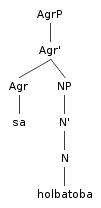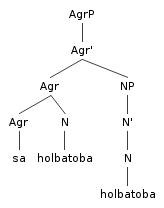In Chocktaw, nouns that act as possessors are marked with agreement by prefixes in a very similar way to how verbs are marked with agreement. (See https://lisatravis2012.wordpress.com/2015/02/10/inflectional-morphology-in-choctaw/). In fact, the agreement morphemes used with possessors are almost exactly identical to the class II and III agreement morphemes on verbs, with the exception of the removal of 1P Multiple forms in possessors, as we can see in the table below.
Moreover, the difference in agreement generally correlates with the traditional notion of alienably and inalienably possessed nouns, where inalienable nouns are those that cannot be dissociated with the noun they are possessing–i.e. body parts, kin, age, mental states, etc.–and alienable nouns are those that can be dissociated–i.e. objects in general, like money, toys, etc. In general in Chocktaw, inalienable nouns are generally marked with class II possessor agreement while alienable nouns are marked with class III.
However, there are difficulties that arise when simply classifying class II as inalienable and class III as alienable in Chocktaw. For example, whereas “my brother’s wife” will take a class II possessor, “my paternal aunt” will take a class III possessor.
(1)
sa-hàyya’
1SII-brother’s.wife
“my brother’s wife”
(2)
a -hokni’
1SIII-father’s.sister
“my paternal aunt”
Furthermore, by referring to the same object with both modifiers, one encounters subtle but different meanings. The following minimal pair demonstrates this distinction:
(3)
sa -hólbatóba’
1SII-picture
“a picture of me” (i.e. a picture with me in it)
(4)
a -hólbatóba’
1SIII-picture
“my picture” (i.e. a picture that belongs to me)
The following trees will depict (3), the class II possessor sa-hólbatóba
Word Structure Tree:
The noun root, hòlbatòba, carries the internal argument of Referent, which is passed up along with the noun feature to its dominating node, where it adjoins with the possessor prefix sa-, which passes up its Internal Argument of Theme as well as its features of first person, singular, and class II to the top N node, which also received the noun feature and <R> argument from the N_<R> node below.
The syntax tree before movement is as follows:
And the syntax tree after movement is quite similar, as is shown below:







